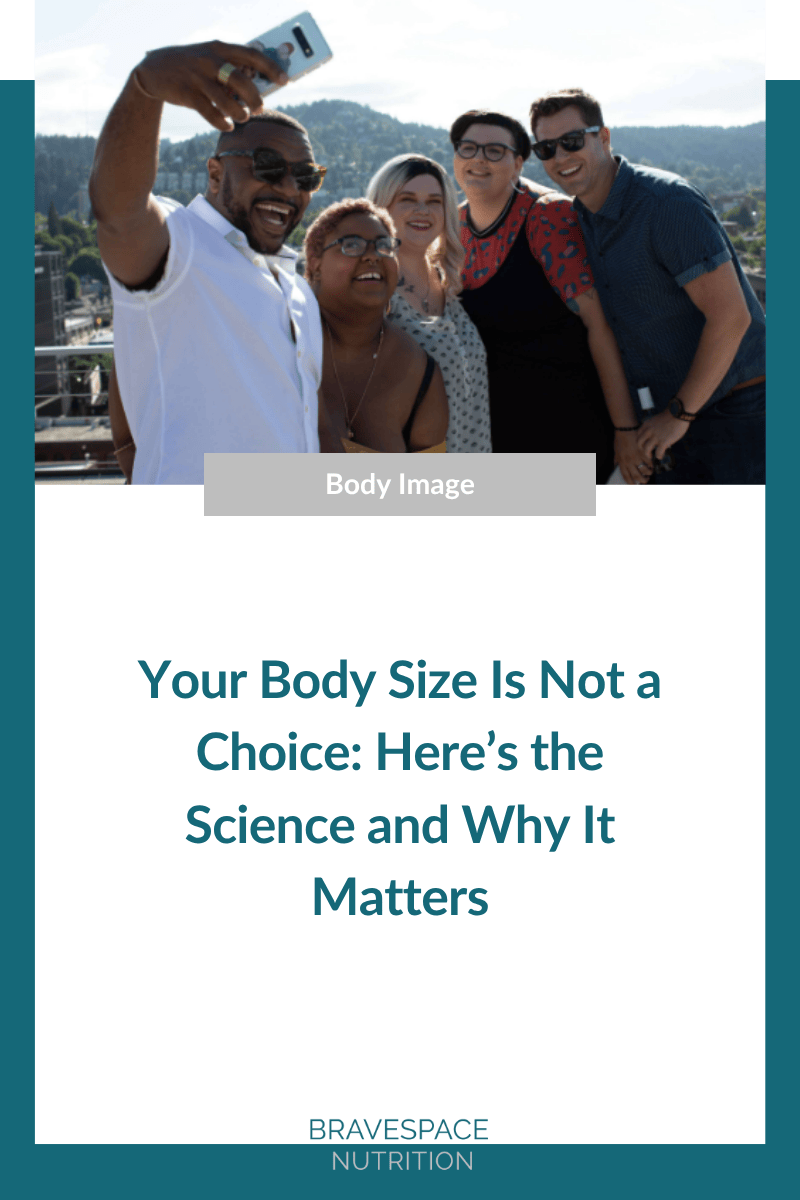Your Body Size Is Not a Choice: Here’s the Science and Why It Matters
Do You Feel Like Your Body Size Is a Choice?
If you’ve ever felt like your body is something you should be able to control, you’re not alone. Diet culture has told you this story since you were a kid: try hard enough, eat “right,” and stay “disciplined,” and your body will do what you want.
But if you’ve ever done everything “right” and your body still wouldn’t cooperate, you’re not alone. The truth is: body size isn’t really a choice. Believing it is can do real harm.
The Willpower Myth We’ve All Been Sold
For most of your life , you’re told weight is simple math: eat less, move more, get smaller. When it doesn’t work long-term, you’re blamed. You didn’t try hard enough, didn’t have enough self-control, didn’t stick to the plan. This is the lie at the heart of diet culture and weight stigma. It frames your natural body size as a moral issue, something to “fix” or “fight.”
Here’s what science actually shows: your body is a living, protective system. Its size is influenced far more by factors outside your control than by willpower.
What Really Determines Body Size
Yes, food and movement matter, but not in the simplistic, “just eat less and move more” way diet culture claims. Your body size is shaped by many factors, including:
Genetics: Just like height or eye color, body size is largely inherited.
Trauma history: Experiences with food insecurity, chronic stress, or other traumas shape metabolism, cravings, and weight.
Medication use: Many prescriptions affect appetite, fluid balance, or metabolism.
Past dieting or restriction: Ironically, the very things we’re told to shrink our bodies can actually make them bigger over time.
Life stage and hormones: Puberty, pregnancy, menopause, and stress all change body composition naturally.
Take a deep breath. If this is new information, let yourself feel whatever comes up: anger, grief, disbelief, relief. These feelings are valid. You’ve been immersed in diet culture your whole life.
Set-Range Theory (Not Just “Set-Point”)
You might have heard of set-point weight theory, which says the body maintains a certain weight. I prefer set-range, because it’s not one exact number, rather it’s a flexible range your body feels safest in.
Here’s the simple version: your hypothalamus acts like a thermostat for body weight. When you dip below your set range (through dieting or eating disorders, for example), your body:
Slows metabolism
Increases hunger hormones and decrease fullness hormones
Fixates on food to restore balance
This isn’t your body “fighting” you, rather it’s protecting you.
Example in real life: Imagine someone who has tried dieting since their teens. Despite following plans “perfectly,” their weight never stays lower for long. That’s not failure. That’s their body operating within its natural set-range, protecting them from deprivation. Understanding this can be life-changing and it shifts blame away from you and toward understanding how bodies work.
How Dieting Can Make Bodies Bigger Over Time
When the body senses deprivation, it shifts into protection mode. Once restriction ends, it wants to store more energy, leading to weight cycling which is losing, regaining, and sometimes ending up heavier than before.
Weight cycling:
Is incredibly common
Impacts metabolism and hunger cues
Teaches the brain that fullness is failure and hunger is dangerous
Try this reflection exercise: How many times have you tried to shrink your body, only to regain weight, or feel worse about yourself? Write it down without judgment. Seeing the pattern on paper often helps people realize it’s the system, not personal weakness, driving these experiences.
This pattern does not help anyone feel peaceful, safe, or healthy in their body.
The Real Harm in Believing “Size Is a Choice”
Believing body size is fully under personal control fuels judgment of yourself and others. It keeps you trapped in comparison and shame, convinces people in larger bodies that they aren’t trying hard enough, convinces people in all size bodies that worth is linked to control, and it ignores how systems like fatphobia, healthcare bias, and weight stigma impact access to care, jobs, and respect.
Bodies come in a wide range of sizes. They always have. They always will.
Challenging the “Control” Myth
Unlearning the belief that size is a choice takes time. Here are ways to start:
1. Let it sink in
Sit with this information. It might feel uncomfortable. That’s okay. No need to “fix” it right away.
2. Notice your feelings
Anger, relief, grief; whatever arises is valid. Give space to these emotions.
3. Reflect on your story
Ask yourself: how has believing body size is controllable affected your life? Journaling can help you process these patterns.
4. Learn from trusted sources
Books like Body Respect (Linda Bacon & Lucy Aphramor) and Health at Every Size offer research-based, anti-diet perspectives. Articles on set-range theory or weight cycling can deepen your understanding.
5. Additional exercises to challenge the myth:
Notice language around weight in media or conversations. Pause when you hear phrases like “just eat less and move more.”
Practice neutral body observations. Notice what your body does daily: walking, hugging, dancing, breathing without labeling it “good” or “bad.”
Create a “body truth” list: write 3–5 things your body does for you that aren’t about appearance.
6. Seek safe support
A weight-inclusive, anti-diet dietitian can help unpack these concepts safely and gently.
You don’t owe anyone thinness. You don’t need to prove health or apologize for your body.
The idea that “fat people are choosing to be fat” is rooted in bias, not truth. Poodle Science humorously demonstrates how absurd it is to expect uniform bodies. Your worth was never meant to be measured in pounds.
A Gentle Reminder as You Keep Going
Undoing decades of body blame is hard. But here’s what you need to remember:
You are not broken.
You are not behind.
You are allowed to rest.
Your body is not a problem to solve.
You are doing brave, generational-healing work just by questioning what you’ve been taught.
You’ll also love…
The Link Between Belonging and Body Image: What You Need to Know
Does Negative Body Image Affect Romantic Relationships?
What’s the Difference Between Overeating and Binge Eating Disorder?
Author bio: Katherine Metzelaar, RDN, CD, is an anti-diet registered dietitian and founder of Bravespace Nutrition. She helps people heal their relationship with food and body image, overcome diet culture pressures, and cultivate a compassionate, non-diet approach to eating and self-care. Katherine empowers her clients to trust their bodies, enjoy food without shame, and experience freedom from restrictive dieting.
Ready for Support That Honors Your Body?
At Bravespace Nutrition, I know how challenging it can be to heal your relationship with food and your body. I offer a pathway to help you heal your body image after years of body hatred, disgust and frustration. I offer a variety of services including nutrition counseling to address body image concerns, disordered eating, eating disorders, chronic dieting, and more! I know how difficult it can be to establish peace with your body, and I’m here to support you in your healing journey. To get started, check out my nutrition services here and schedule a free 15-minute discovery phone call today with an anti-diet dietitian




